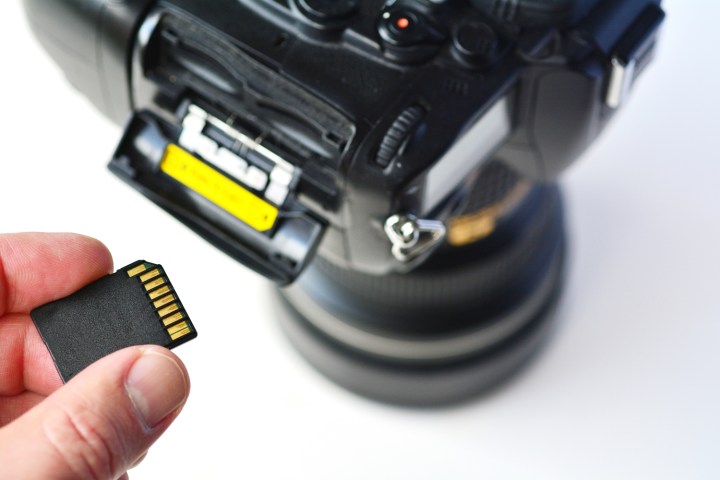
Digital Trends recently spoke with Steffi Ho, product manager at Lexar, about what makes one card better than another, how Lexar ensures reliability with its products, and the high-end format war between CFast and XQD.
Size matters, but so does speed
Consumers are generally aware that memory cards come in different capacities, but may be less knowledgeable about card speeds. It’s speed, not size, that differentiates a high-end card from an entry-level one, but this is also the source of the greatest confusion.
“Even for our MicroSD lineup right now, we have five different lines,” Ho told us. Furthermore, each card may have up to five different labels that indicate its speed. “You’ve got the transfer speed, you’ve got the X-rating, and on top of that there’s the U1 [or U3], UHS, and Class 10,” said Ho. “I definitely think it can be overwhelming.”
Transfer speed (or read speed) is how quickly data can be downloaded off of the card, so a higher transfer speed means it will take less time to import photos to your computer. The write speed is what determines how a card performs in a host device, and isn’t always spelled out. That’s where the speed class comes in. Class 10 implies a sustained write speed of at least 10 megabytes per second, while the new Ultra High Speed (UHS and UHS-II) category can be either U1 (also 10 megabytes per second) or U3 (30 megabytes per second).
Spurred on by new demand from small 4K action cameras and drones, Lexar’s fastest UHS-II MicroSD cards push 270 megabytes per second (1800x), eclipsing even the best CF cards. (But SanDisk wears the crown here with its ExtremePro MicroSD card, which reaches 275 megabytes per second.) That’s enough performance for all but the most demanding professional uses, and it comes at a cost: Lexar’s 128GB 1800x MicroSD carries a list price of $275, although it can be found for as little as $128 from various online retailers. It also includes a handy USB 3 card reader, and an optional iOS-compatible reader is available, perfect for offloading action camera footage in the field.
While most users don’t need that much performance, as Ho explained it, it’s important that consumers are aware of different card speeds, even if an entry-level card will serve them today. “As time goes on, users are going to want to shoot RAW, shoot 4K,” she said. For
The GoPro Hero4 Black, for example, requires only a Class 10 card for 4K video. Sony’s RX and Alpha series cameras, on the other hand, require at least a U1-rated card for
Reliability through testing
Perhaps the most important factor of any good memory card is reliability. There’s nothing worse than powering on a camera only to be greeted with an error message, and nobody wants to endure the pain of data loss. There isn’t a label that indicates how reliable a card is, but some brands have better track records. This is often the unseen feature that makes one brand of card more expensive than another. Lexar puts a significant amount of time into testing its cards before they hit the market, in order to minimize the chance of card errors.
“In our Lexar quality lab, we have over 1,400 devices that we test our products on,” Ho explained. These range from phones and action cameras to professional DSLRs and more. “We also work really closely with camera manufacturers to ensure compatibility.”
When the Nikon D5 and D500 professional DSLRs launched earlier this year, there was initially a problem with Lexar’s latest XQD and UHS-II SD cards in these new cameras. Lexar actually sent a team of engineers to Japan to meet with Nikon to work out the issue. Nikon soon after released a firmware update that solved the problem.
XQD versus CFast: New formats for professionals

These new formats lead the way by a fair margin when it comes to speed. Currently, CFast holds the record at 540 megabytes per second (3600x), while XQD lags slightly behind at a still-respectable 440 megabytes per second (2933x). (Lexar also makes a slower XQD card, at 210 megabytes per second, or 1400x.)
Support for each format is divided among brands. Sony and Nikon favor the physically smaller (and significantly less expensive) XQD, while Canon and high-end cinema camera manufacturers, like ARRI, have stuck by CFast. CFast has a lead for now, but Ho believes it won’t last long.
“The theoretical limit is 600 megabytes per second for CFast,” she explained. “It’s 1,000 megabytes per second for XQD.” This means that, eventually, XQD could become the preferred choice for high-end professionals, especially considering its cost advantage. (Lexar also makes CFast cards, while SanDisk and Kingston have not announced any plans to support XQD.)
As for the future, 8K video is the next big thing that will push memory card limits, but Ho believes existing formats will continue to handle the needs of the market for some time to come. “We’re always going to see these bumps in performance,” she said. “But host device manufacturers tend to lag behind storage performance.” Currently, no camera takes full advantage of the fastest memory cards, but it won’t stay that way forever, as history has shown. “It’s just a matter of time,” Ho said.
Updated August 22. This article originally stated the Lexar Professional MicroSD card included an iOS-compatible card reader. The card includes a USB 3 card reader; the iOS reader is available as an optional accessory.
Editors' Recommendations
- The Samsung Galaxy S21 doesn’t have an SD card slot, and I don’t care
- SanDisk’s $450 microSD card adds 1TB more storage to your Surface Pro





